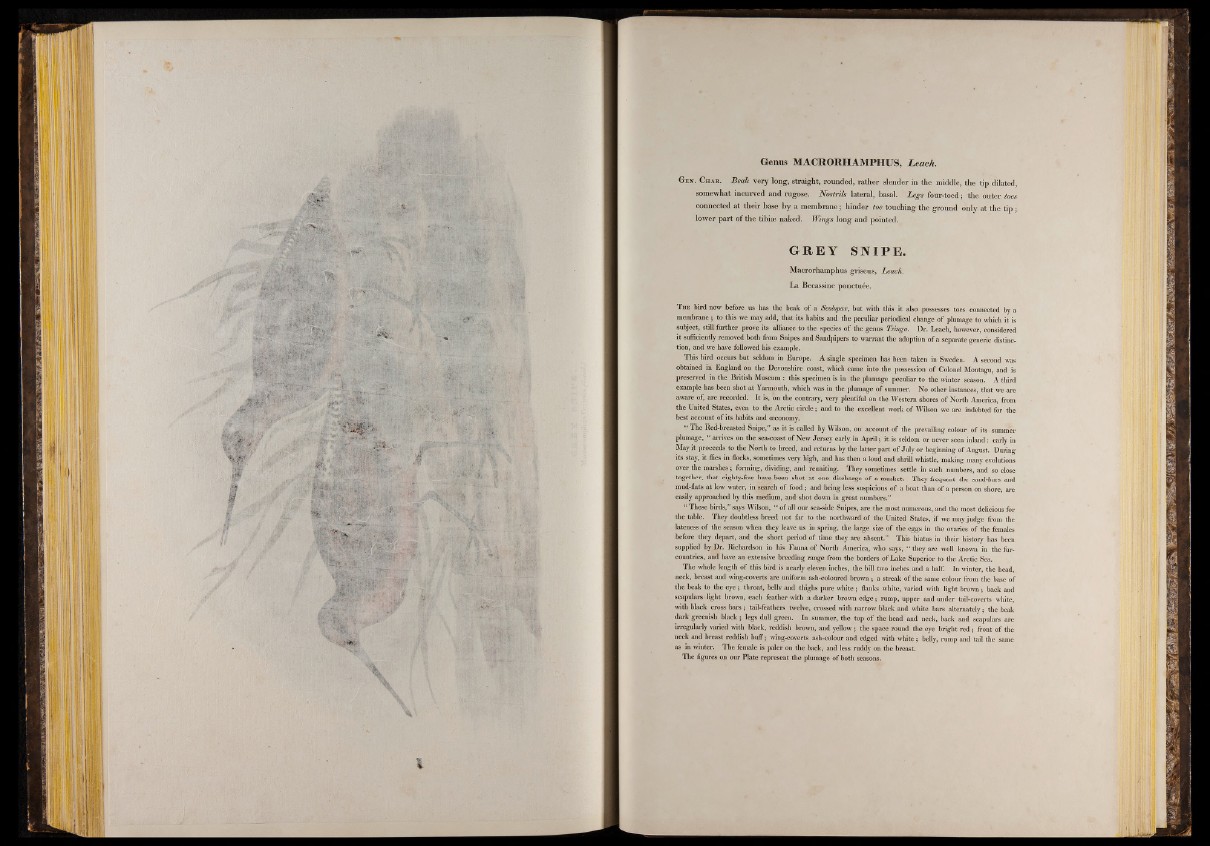
Genus MACRORHAMPHUS, Leach.
G e n . Char. B e a k v e r y lo n g , straigh t, round ed , rath e r slend er in th e middle, th e tip dilated,
somewhat in cu rv ed and rugose. N os tr ils lateral, basal. L e g s four-toed ; th e o u te r toes
connected a t th e ir base b y a membrane ; hin d e r toe tou ch in g th e g roun d o n ly a t th e tip ;
low e r p a rt o f the tibiae naked. Wings lo n g and pointed.
GR E Y SNIPE.
M ac rorh amphu s griseus, Leach.
L a Bécassine ponctuée.
T h e bird now before us has the beak o f a Scolopaw, but with this it also possesses toes connected by a
membrane ; to this we may add, that its habits and the peculiar periodical change o f plumage to which it is
subject, still further prove its alliance to the species o f the genus Tringa. Dr. Leach, however, considered
it sufficiently removed both from Snipes and Sandpipers to warrant the adoption o f a separate generic distinction,
and we have followed his example.
This bird occurs but seldom in Europe. A single specimen has been taken in Sweden. A second was
obtained in England on the Devonshire coast, which came into the possession o f Colonel Montagu, and is
preserved in the British Museum : this specimen is in the plumage peculiar to the winter season. A third
example has been shot at Yarmouth, which was in the plumage o f summer. No other instances, that we are
aware of, are recorded. It is, on the contrary, very plentiful on the Western shores o f North America, from
the United States, even to the Arctic circle ; and to the excellent work o f Wilson we are indebted for the
best account o f its habits and oeconomy.
“ The Red-breasted Snipe,” as it is called by Wilson, on account o f the prevailing colour o f its summer
plumage, “ arrives on the sea-coast o f New Jersey early in April ; it.is seldom or never seen inland : early in
May it proceeds to the North to breed, and returns by the latter part o f July or beginning o f August. During
its stay, it flies in flocks, sometimes very higb, and has then a loud and shrill whistle, making many evolutions
over the marshes ; forming, dividing, and reuniting. They sometimes settle in such numbers, and so close
together, that eighty-five have.been shot at one discharge o f a musket. They frequent the sand-bars and
mud-flats at low water, in search o f food ; and being less suspicious o f a boat than of a person on shore, are
easily approached by this medium, and shot down in great numbers.”
“ These birds,” says Wilson, “ o f all our sea-side Snipes, are the most numerous, and the most delicious for
the table. They doubtless breed not far to the northward o f the United States, i f we may judge from the
lateness of the season when they leave us in spring, the large size o f the eggs in the ovaries o f the females
before they depart, and the short period o f time they are absent.” This hiatus in their history has been
supplied by Dr. Richardson in his Fauna o f North America, who says, “ they are well known in the fur-
countries, and have an extensive breeding range from the borders o f Lake Superior to the Arctic Sea.
The whole length o f this bird is nearly eleven inches, the bill two inches and a half. In winter, the head,
neck, breast and wing-coverts are uniform ash-coloured brown ; a streak o f the same colour from the base of
the beak to the eye ; throat, belly and thighs pure white ; flanks white, varied with light brown ; back and
scapulars light brown, each feather with a darker brown edge ; rump, upper and under tail-coverts white,
with black cross bars ; tail-feathers twelve, crossed with narrow black and white bars alternately ; the beak
dark greenish black ; legs dull green. In summer, the top o f the head and neck, back and scapulars are
irregularly varied with black, reddish brown, and yellow ; the space round the eye bright red ; front o f the
neck and breast reddish buff ; wing-coverts ash-colour and edged with white ; belly, rump and tail the same
as in winter. The female is paler on the back, and less ruddy on the breast.
The figures on our Plate represent the plumage o f both seasons.